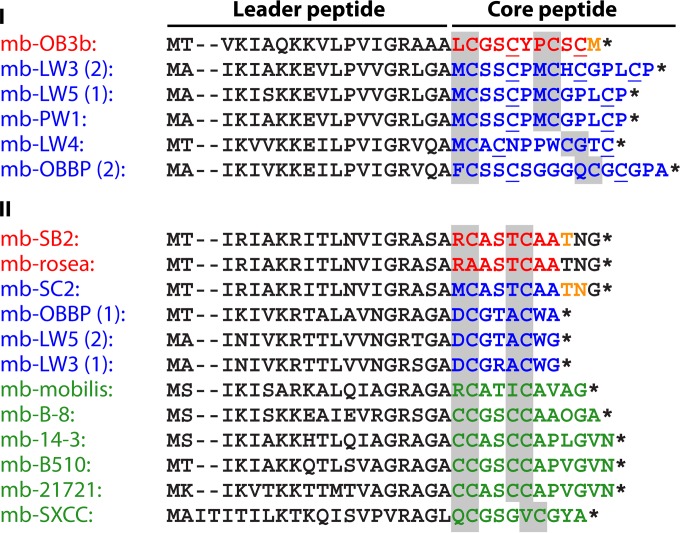FIG 4.
mb precursor peptides. Sequences were detected in bacteria with known genome sequences, in methanotrophs with characterized mbs as well as from other methanotrophs, and from selected nonmethanotrophs, directly from the DNA sequence using Fuzztran in Mobyle (http://mobyle.pasteur.fr), with the optimized mb sequence motif (Prosite format) [ILMV]-[AIKST](1,3)-[IV]-[KNRT]-[IV]-X-[AKQ]-[KRT]-X-[ILM]-X-[IV]-X-[GV]-R-X(2)-[AL]-X-C(1,2)-[GA](0,1)-[ST](0,2)-X(0,2)-C(1,2) as a query. Only sequences also featuring downstream mb biosynthesis cassette genes mbnB and mbnC (see the text and Table 2) are shown. Known and predicted leader sequences and sequences not observed in the final product are shown in black, sequences detected in bacteria of known genome sequence from methanotrophs with mbs either whose crystal structure has been determined (mb-OB3b) or whose primary structures were predicted (mb-SB2 and mb-rosea) are shown in red, sequences detected in bacteria of known genome sequence from methanotrophs are shown in blue, and sequences detected in bacteria of known genome sequence from nonmethanotrophs are shown in green. Amino acids observed in some but not all samples are shown in tan. Amino acids with a gray background represent the amino acid pair shown or predicted to be posttranslationally modified into an oxazolone, imidazolone, or pyrazinedione group in structurally characterized mbs; underlined Cs represent Cys residues known or predicted to be present in the mature peptide. mbs were from M. trichosporium OB3b (mb-OB3b), Methylosinus sp. strains LW3 (mb-LW3), LW4 (mb-LW4), and PW1 (mb-PW1), M. parvus OBBP (mb-OBBP), M. rosea (mb-rosea), Methylocystis strains SB2 (mb-SB2), SC2 (mb-SC2), and LW5 (mb-LW5), Cupriavidus basiliensis B-8 (mb-B-8), Pseudomonas extremaustralis 14-3 (mb-14-3), Azospirillum sp. strain B510 (mb-B510), Tistrella mobilis KA081020-065 (mb-mobilis), Comamonas composti DSM 21721 (mb-21721), and Gluconoacetobacter sp. strain SXCC (mb-SXCC). Numbers in parentheses after a strain name are used for species with more than one mb gene cluster. Stop codons are indicated by an asterisk and gaps in the sequence alignment by a hyphen.

